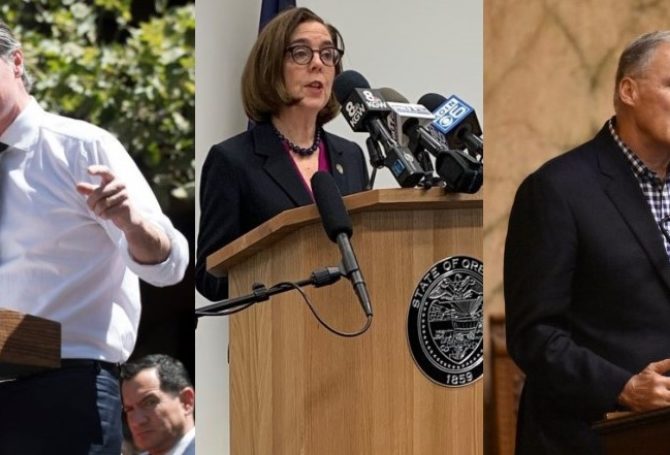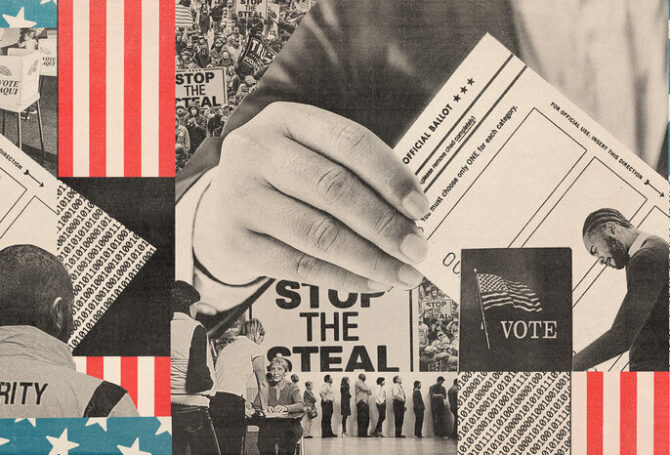
Even though the COVID-19 outbreak has not fully crested across the nation, a debate has erupted over when and by whom to open up the country again. President Trump says it’s his call and has pegged May 1 as a potential reopening date. The governors of Oregon, Washington and California have formed a Western States Pact, promised to act in concert and said they will only lift lockdown orders after health data says it would be safe.
“We need to see a decline in the rate of spread of the virus before large-scale reopening, and we will be working in coordination to identify the best metrics to guide this,” according to a joint statement from Governors Kate Brown, Jay Inslee and Gavin Newsom. In a separate statement, Newsom said California’s reopening plan would be guided by facts, evidence and science.
Leaders in several Eastern states, including hard-hit New York, have formed a similar pact. New Jersey Governor Phil Murphy said on “Face the Nation” over the weekend that he and his counterparts in New York, Pennsylvania and Connecticut are working in close coordination and would oppose restarting the economy before they are assured it wouldn’t reignite the spread of COVID-19 virus. Massachusetts, Rhode Island and Delaware are also part of the pact.
The issue of who can order an end to the near-national lockdown roared into the headlines after Trump said, “The president of the United States calls the shots. They [states] can’t do anything without the approval of the president of the United States.”
Trump’s assertion drew a sharp response from governors. “Well, seeing as we had the responsibility for closing the state down,” Pennsylvania Governor Tom Wolf said, “I think we probably have the primary responsibility for opening it up.” New York Governor Andrew Cuomo was harsher in his rebuke. “We don’t have a king. We have an elected president. The Constitution clearly says the powers that are not specifically listed for the federal government are reserved for the states, and the bounds between federal and state authority are central to the Constitution – one of the great balances of power.”
The governors, including Brown, are siding with public health experts by favoring a gradual reopening following massive testing to determine how far the virus has spread, aggressive contact tracing to see how the virus could spread and focused restrictions on people who are infected or have come into contact with people who are infected. Utah and Massachusetts, the latter of which is seeing cresting numbers of confirmed COVID-19 cases and deaths, are already implementing similar ambitious plans.
However, state priorities can only stretch as far as their financial resources will reach. Drastically expanding testing will cost a lot of money. Contact tracing presents both technical and privacy concerns. Focused restrictions might be difficult to explain and enforce.
There seems to be indisputable evidence that social distancing has slowed the spread of the virus and avoided sharply higher mortality projections. The question is how sustainable self-quarantining behavior can be, especially in a badly damaged economic environment that is challenging many people’s ability to buy food, pay rent and afford medical care and that threatens the continued viability of thousands of small businesses. As such, reopening the nation’s economy is devolving into a partisan issue.
The governors working together on a gradual, targeted economic reopening are under their own pressures, as state tax revenues plummet while financial demands increase for skyrocketing unemployment insurance claims, enlarging Medicaid enrollment and depleting food banks. The states on the Western and Eastern ends of the country are also in different places in terms of the arc of the outbreak itself. New York has been the US epicenter of the pandemic, while new cases and deaths are still increasing in Massachusetts. Policies in place on the West Coast, including Washington, the original US epicenter for the coronavirus outbreak, have resulted in far fewer infections and deaths than originally projected.
What worries public health experts and the governors on both coasts is a premature relaxation of restrictions that produces a renewed wave of infections and a need to reinstate the lockdown. The key to any roadmap for reopening the economy appears to center on mass testing. While some 2 million Americans have been tested for COVID-19, no one really knows how widely the disease has spread and who would pose a risk or be at risk. The answer to the testing dilemma appears to be easy-to-administer blood tests that generate quick positive or negative results for the infection. Tied to testing is the search for and harvesting of antibodies that can aid treatment of badly infected patients.
The logistical demands of massive blood testing – healthcare personnel, equipment, laboratory capacity and data analysis – are daunting. No individual state or even a group of states could pull it off on their own. Moreover, the movement between states that have conducted extensive testing and those that haven’t could render the exercise meaningless. The testing would have to occur under a federal umbrella, which makes the current standoff between Trump and states, most of which have Democratic governors, all the more problematic.
In a press conference Tuesday, Brown reiterated the need for robust testing and an aggressive contact tracing and selective isolation strategy. She said she wants to be assured Oregon has enough hospital beds and protective equipment for medical workers in case the virus flares up again after restrictions are relaxed.
Brown set no timeline. “A shuttering of the economy on this scale has never happened before, and neither has a reopening strategy on this level.” She indicated she will reach out to leaders in some of the hardest hit industries for suggestions on an “incremental release” of restrictions.
Coupled with restarting the economy are questions about legislative action at a special session, which may be needed for a variety of industries, municipal governments and nonprofits still waiting for support from the federal government and not entirely covered by the CARES Act. At this time, there is no concrete information on when a special session will be called by Brown or legislative leadership, other than it could be in late May or even June.Oregon is one of only 15 states that has failed to take legislative action in response to the COVID-19 pandemic.According to NCSL, 35 states have enacted legislation or made budget allocations to address challenges from the virus.
While bipartisan calls for a special session have been loud and persistent,
Brown has thus far resisted them. She is waiting to receive two economic data
points. The first, which is expected next week, is from the Legislative Revenue
Office delineating what federal funds Oregon will receive and how they might
fill holes in the state budget. Oregon expects to receive at least $1.2 billion
and possibly up to $1.6 billion in federal funds as part of the CARES Act
passed by Congress. The second data point is the quarterly state revenue
forecast, slated for mid-May. While the state has a $2 billion rainy-day fund,
the state Office of Economic Analysis will likely forecast a steep drop in
state revenue over the next biennium. Once the state better understands the
CARES Act funding, and how much money they have to plug in, Brown will feel
more comfortable calling a targeted special session.



